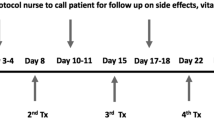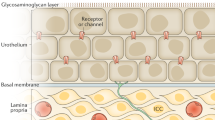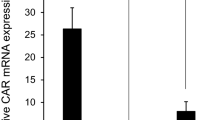Abstract
Three drugs were compared for their efficacy in treating murine transitional cell carcinoma (TCC) of the bladder. Intravesical gene therapy treatments utilizing expression-targeted plasmids, where the murine cyclooxygenase-2 (Cox-2) promoter was used to drive the expression of exogenously inducible forms of caspases 3 and 9, were compared with treatment modalities employing Bacille Calmette-Guérin (BCG) and celecoxib. When administered via lavage, only the gene therapy regimen was found to be effective at restricting tumor progression following a 7-day incubation of tumor tissues. Celecoxib was also administered via the diet to allow for systemic delivery of the drug. The most efficacious celecoxib use tested yielded tumors with masses of (18.3±8.4 mg) versus the gene delivery method, which yielded tumors with masses of (3.6±7.7 mg). The difference was significant (t-test, n⩾4, P<0.025). The results showed that the Cox-2 expression-targeted gene therapy system could efficiently bypass the bladder permeability barrier and more effectively inhibit tumor growth and development than either BCG or celecoxib treatments. Long-term data further demonstrated that the gene therapy system could effectively inhibit tumor growth and elongate life expectancy.
This is a preview of subscription content, access via your institution
Access options
Subscribe to this journal
Receive 12 print issues and online access
$259.00 per year
only $21.58 per issue
Buy this article
- Purchase on Springer Link
- Instant access to full article PDF
Prices may be subject to local taxes which are calculated during checkout







Similar content being viewed by others
References
Shen Z, Shen T, Wientjes MG, O'Donnell MA, Au JL . Intravesical treatments of bladder cancer: review. Pharm Res 2008; 25: 1500–1510.
Pearl R . Cancer and tuberculosis. Am J Hyg 1929; 9: 97–159.
Razack AH . Bacillus Calmette-Guerin and bladder cancer. Asian J Sur 2007; 30: 302–309.
Baron JA, Cole BF, Sandler RS, Haile RW, Ahnen D, Bresalier R et al. A randomized trial of aspirin to prevent colorectal adenomas. N Engl J Med 2003; 348: 891–899.
Kawamori T, Rao CV, Seibert K, Reddy BS . Chemopreventive activity of celecoxib, a specific cyclooxygenase-2 inhibitor, against colon carcinogenesis. Cancer Res 1998; 58: 409–412.
Reddy BS, Hirose Y, Lubet R, Steele V, Kelloff G, Paulson S et al. Chemoprevention of colon cancer by specific cyclooxygenase-2 inhibitor, celecoxib, administered during different stages of carcinogenesis. Cancer Res 2000; 60: 293–297.
Altorki NK, Keresztes RS, Port JL, Libby DM, Korst RJ, Flieder DB et al. Celecoxib, a selective cyclo-oxygenase-2 inhibitor, enhances the response to preoperative paclitaxel and carboplatin in early-stage non-small-cell lung cancer. J Clin Oncol 2003; 21: 2645–2650.
Diperna CA, Bart RD, Sievers EM, Ma Y, Starnes VA, Bremner RM . Cyclooxygenase-2 inhibition decreases primary and metastatic tumor burden in a murine model of orthotopic lung adenocarcinoma. J Thorac Cardiovasc Surg 2003; 126: 1129–1133.
Liu W, Chen Y, Wang W, Keng P, Finkelstein J, Hu D et al. Combination of radiation and celebrex (celecoxib) reduce mammary and lung tumor growth. Am J Clin Oncol 2003; 26: S103–S109.
Alshafie GA, Abou-Issa HM, Seibert K, Harris RE . Chemotherapeutic evaluation of celecoxib, a cyclooxygenase-2 inhibitor, in a rat mammary tumor model. Oncol Rep 2000; 7: 1377–1381.
Harris RE, Alshafie GA, Abou-Issa H, Seibert K . Chemoprevention of breast cancer in rats by celecoxib, a cyclooxygenase 2 inhibitor. Cancer Res 2000; 60: 2101–2103.
Kundu N, Fulton AM . Selective cyclooxygenase (COX)-1 or COX-2 inhibitors control metastatic disease in a murine model of breast cancer. Cancer Res 2002; 62: 2343–2346.
Hsu AL, Ching TT, Wang DS, Song X, Rangnekar VM, Chen CS . The cyclooxygenase-2 inhibitor celecoxib induces apoptosis by blocking Akt activation in human prostate cancer cells independently of Bcl-2. J Biol Chem 2000; 275: 11397–11403.
Patel MI, Subbaramaiah K, Du B, Chang M, Yang P, Newman RA et al. Celecoxib inhibits prostate cancer growth: evidence of a cyclooxygenase-2-independent mechanism. Clin Cancer Res 2005; 11: 1999–2007.
Fu SL, Wu YL, Zhang YP, Qiao MM, Chen Y . Anti-cancer effects of COX-2 inhibitors and their correlation with angiogenesis and invasion in gastric cancer. World J Gastroenterol 2004; 10: 1971–1974.
Dhawan D, Jeffreys AB, Zheng R, Stewart JC, Knapp DW . Cyclooxygenase-2 dependent and independent antitumor effects induced by celecoxib in urinary bladder cancer cells. Mol Cancer Ther 2008; 7: 897–904.
Grubbs CJ, Lubet RA, Koki AT, Leahy KM, Masferrer JL, Steele VE et al. Celecoxib inhibits N-butyl-N-(4-hydroxybutyl)-nitrosamine-induced urinary bladder cancers in male B6D2F1 mice and female Fischer-344 rats. Cancer Res 2000; 60: 5599–5602.
Hawkey CJ . COX-2 inhibitors. Lancet 1999; 353: 307–314.
Arber N, Eagle CJ, Spicak J, Racz I, Dite P, Hajer J et al. Celecoxib for the prevention of colorectal adenomatous polyps. N Engl J Med 2006; 355: 885–895.
Solomon SD, Pfeffer MA, McMurray JJ, Fowler R, Finn P, Levin B et al. Effect of celecoxib on cardiovascular events and blood pressure in two trials for the prevention of colorectal adenomas. Circulation 2006; 114: 1028–1035.
Pagliaro LC, Keyhani A, Williams D, Woods D, Liu B, Perrotte P et al. Repeated intravesical instillations of an adenoviral vector in patients with locally advanced bladder cancer: a phase I study of p53 gene therapy. J Clin Oncol 2003; 21: 2247–2253.
Kuball J, Wen SF, Leissner J, Atkins D, Meinhardt P, Quijano E et al. Successful adenovirus-mediated wild-type p53 gene transfer in patients with bladder cancer by intravesical vector instillation. J Clin Oncol 2002; 20: 957–965.
Malmström PU, Loskog AS, Lindqvist CA, Mangsbo SM, Fransson M, Wanders A et al. AdCD40L immunogene therapy for bladder carcinoma–the first phase I/IIa trial. Clin Cancer Res 2010; 16: 3279–3787.
Godbey WT, Atala A . Directed apoptosis in Cox-2-overexpressing cancer cells through expression-targeted gene delivery. Gene ther 2003; 10: 1519–1527.
Zhang X, Atala A, Godbey WT . Expression-targeted gene therapy for the treatment of transitional cell carcinoma. Cancer Gene Ther 2008; 15: 543–552.
Mohammed SI, Knapp DW, Bostwick DG, Foster RS, Khan KN, Masferrer JL et al. Expression of cyclooxygenase-2 (COX-2) in human invasive transitional cell carcinoma (TCC) of the urinary bladder. Cancer Res 1999; 59: 5647–5650.
Basu GD, Pathangey LB, Tinder TL, Lagioia M, Gendler SJ, Mukherjee P . Cyclooxygenase-2 inhibitor induces apoptosis in breast cancer cells in an in vivo model of spontaneous metastatic breast cancer. Mol Cancer Res 2004; 2: 632–642.
Carothers AM, Moran AE, Cho NL, Redston M, Bertagnolli MM . Changes in antitumor response in C57BL/6J-Min/+ mice during long-term administration of a selective cyclooxygenase-2 inhibitor. Cancer Res 2006; 66: 6432–6438.
Gupta S, Adhami VM, Subbarayan M, MacLennan GT, Lewin JS, Hafeli UO et al. Suppression of prostate carcinogenesis by dietary supplementation of celecoxib in transgenic adenocarcinoma of the mouse prostate model. Cancer Res 2004; 64: 3334–3343.
Hudson MA, Ritchey JK, Catalona WJ, Brown EJ, Ratliff TL . Comparison of the fibronectin-binding ability and antitumor efficacy of various mycobacteria. Cancer Res 1990; 50: 3843–3847.
Zhang X, Turner C, Godbey WT . Comparison of caspase genes for the induction of apoptosis following gene delivery. Mol Biotechnol 2009; 41: 236–246.
Morales A, Eidinger D, Bruce AW . Intracavitary Bacillus Calmette-Guerin in the treatment of superficial bladder tumors. J Urol 1976; 116: 180–183.
Morales A, Nickel JC . Immunotherapy for superficial bladder cancer. A developmental and clinical overview. Urol Clin N Am 1992; 19: 549–556.
O'Donnell MA, DeWolf WC . Bacillus Calmette-Guerin immunotherapy for superficial bladder cancer. New prospects for an old warhorse. Surg Oncol Clin N Am 1995; 4: 189–202.
Ratliff TL . Role of the immune response in BCG for bladder cancer. Eur Urol 1992; 21 (Suppl 2): 17–21.
Cheng DL, Shu WP, Choi JC, Margolis EJ, Droller MJ, Liu BC . Bacillus Calmette-Guerin interacts with the carboxyl-terminal heparin binding domain of fibronectin: implications for BCG-mediated antitumor activity. J Urol 1994; 152: 1275–1280.
Kavoussi LR, Brown EJ, Ritchey JK, Ratliff TL . Fibronectin-mediated Calmette-Guerin bacillus attachment to murine bladder mucosa. Requirement for the expression of an antitumor response. J Clin Invest 1990; 85: 62–67.
Becich MJ, Carroll S, Ratliff TL . Internalization of bacille Calmette-Guerin by bladder tumor cells. J Urol 1991; 145: 1316–1324.
Kuroda K, Brown EJ, Telle WB, Russell DG, Ratliff TL . Characterization of the internalization of bacillus Calmette-Guerin by human bladder tumor cells. J Clin Invest 1993; 91: 69–76.
Prescott S, James K, Hargreave TB, Chisholm GD, Smyth JF . Intravesical Evans strain BCG therapy: quantitative immunohistochemical analysis of the immune response within the bladder wall. J Urol 1992; 147: 1636–1642.
Wolfe SA, Tracey DE, Henney CS . Introduction of ‘natural’ killer' cells by BCG. Nature 1976; 262: 584–586.
Kurumbail RG, Stevens AM, Gierse JK, McDonald JJ, Stegeman RA, Pak JY et al. Structural basis for selective inhibition of cyclooxygenase-2 by anti-inflammatory agents. Nature 1996; 384: 644–648.
Jerry GR, Chandan C, Peeyush KL . Cyclooxygenase inhibitors retard murine mammary tumor progression by reducing tumor cell migration, invasiveness and angiogenesis. Int J Cancer 2001; 93: 497–506.
Tsujii M, Kawano S, Tsuji S, Sawaoka H, Hori M, DuBois RN . Cyclooxygenase regulates angiogenesis induced by colon cancer cells. Cell 1998; 93: 705–716.
Tyagi P, Wu P-C, Chancellor M, Yoshimura N, Huang L . Recent advances in intravesical drug/gene delivery. Mol Pharm 2006; 3: 369–379.
Bevers RF, Kurth KH, Schamhart DH . Role of urothelial cells in BCG immunotherapy for superficial bladder cancer. Br J Cancer 2004; 91: 607–612.
Schamhart DH, De Boer EC, Vleeming R, Kurth KH . Theoretical and experimental evidence on the use of glycosaminoglycans in BCG-mediated immunotherapy of superficial bladder cancer. Semin Thromb Hemost 1994; 20: 301–309.
Ratliff TL, Palmer JO, McGarr JA, Brown EJ . Intravesical Bacillus Calmette-Guerin therapy for murine bladder tumors: initiation of the response by fibronectin-mediated attachment of Bacillus Calmette-Guerin. Cancer Res 1987; 47: 1762–1766.
Gunther JH, Jurczok A, Wulf T, Brandau S, Deinert I, Jocham D et al. Optimizing syngeneic orthotopic murine bladder cancer (MB49). Cancer Res 1999; 59: 2834–2837.
Godbey WT, Wu KK, Hirasaki GJ, Mikos AG . Improved packing of poly(ethylenimine)/DNA complexes increases transfection efficiency. Gene Ther 1999; 6: 1380–1388.
Acknowledgements
We would like to thank Sherri R Godbey, MD, for assistance with obtaining Celebrex, Carol Pilbeam, PhD, for originally providing the TIS10 (murine Cox-2) promoter, David Spencer, PhD, for originally providing the inducible caspase exons, and ARIAD (http://www.ariad.com/regulationkits) for providing significant amounts of AP20187. This work was funded by the National Science Foundation CAREER award (CBET-0846395).
Author information
Authors and Affiliations
Corresponding author
Ethics declarations
Competing interests
The authors declare no conflict of interest.
Rights and permissions
About this article
Cite this article
Zhang, X., Godbey, W. Preclinical evaluation of a gene therapy treatment for transitional cell carcinoma. Cancer Gene Ther 18, 34–41 (2011). https://doi.org/10.1038/cgt.2010.50
Received:
Revised:
Accepted:
Published:
Issue Date:
DOI: https://doi.org/10.1038/cgt.2010.50
Keywords
This article is cited by
-
Preclinical evaluation of VAX-IP, a novel bacterial minicell-based biopharmaceutical for nonmuscle invasive bladder cancer
Molecular Therapy - Oncolytics (2016)
-
Antitumor effects of bladder cancer-specific adenovirus carrying E1A-androgen receptor in bladder cancer
Gene Therapy (2012)
-
Molecular biomarkers in urothelial carcinoma of the bladder: are we there yet?
Nature Reviews Urology (2012)



